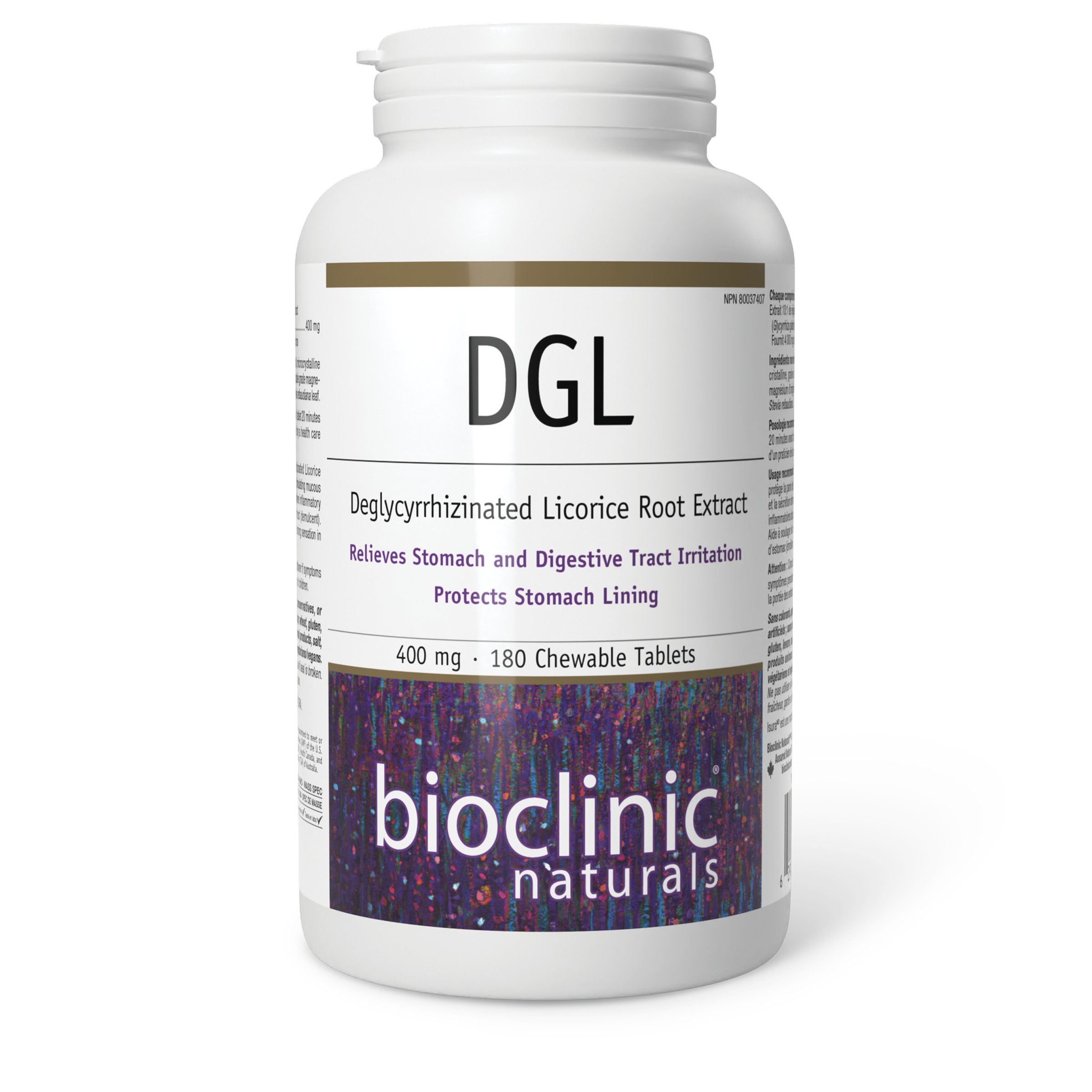
Deglycyrrhizinated Licorice Root Extract
400 mg
180 Chewable Tablets ( SKU: 9227, NPN: 80037407 )
Benefits
- Provides deglycyrrhizinated licorice (DGL) in chewable tablets, the form associated with the greatest clinical efficacy, as it allows for licorice to be released in the stomach and dispersed/absorbed by the gastric mucosa
- Offers 400 mg of DGL per tablet, the clinically effective dosage
- Deglycyrrhizination prevents adverse effects associated with licorice consumption
- Pleasant-tasting tablets for better compliance
- Suitable for vegetarians/vegans
Feature Summary
DGL, has been used clinically for decades, primarily for protecting the gastrointestinal mucosal lining.1 Licorice has many triterpenoids and hundreds of flavonoids that have been shown to inhibit several inflammatory enzymes, including both cyclooxygenase-2 (COX-2) and 5-lipoxygenase (5-LOX). These enzymes decrease the production of several potent inflammatory compounds, including IL-6, prostaglandin E2, thromboxane B2, and leukotriene B4.2 Importantly, this inhibition is not primarily due to glycyrrhizic acid, the component of licorice that has been removed in DGL and that is associated with mineralocorticoid excess and hypertension.3 Licorice has multiple active compounds with anti-inflammatory, anti-microbial, and anti-allergic actions, including glabridin and at least seven licochalcones. The compounds have been shown to prevent lipopolysaccharide-induced (LPS) production of inflammatory compounds, inhibit yeast and bacterial biofilm formation, and upregulate antioxidant enzymes.4-6
Clinically, a combination product including DGL has been shown to have comparable efficacy to cimetidine for both the healing and prevention of of irritation of the gastrointestinal mucosa.7 Additionally, extracts of licorice have been shown to inhibit the adhesion of H. pylori to gastric mucosa, as well as the growth of resistant strains, suggesting multiple mechanisms of protection for the gastrointestinal lining.8,9 The use of chewable tablets appears necessary for DGL’s efficacy as it allows for distribution and absorption by the gastric mucosa.7
Medicinal Ingredients
| Each Tablet Contains: | |
| Deglycyrrhizinated Licorice 10:1 Extract (Glycyrrhiza glabra) (root) | 400 mg |
| Providing 4,000 mg crude herb licorice | |
Non-Medicinal Ingredients
Xylitol, microcrystalline cellulose, aniseed, stearic acid, vegetable grade magnesium stearate(lubricant), silica, Stevia rebaudiana leaf.
Dosage:
Chew 1 tablet 20 minutes prior to each meal, or as directed by a health care practitioner.
Warnings:
Consult a health care practitioner if symptoms persist or worsen. Keep out of reach of children.
Allergens:
Contains no artificial colours, preservatives, or sweeteners; no dairy, starch, sugar, wheat, gluten, yeast, soy, egg, fish, shellfish, animal products, salt, tree nuts, or GMOs. Suitable for vegetarians/vegans. Sealed for your protection. Do not use if seal is broken. For freshness, store in a cool, dry place.
Drug Interactions
No known drug interactions. Licorice influences the activity of several cytochrome enzymes and reduces warfarin activity in animal models, likely due to glycyrrhizic acid activity. DGL use should be carefully monitored in these patients.
- Turpie, A.G., Runcie, J., & Thomson, T.J. (1969). Clinical trial of deglydyrrhizinized liquorice in gastric ulcer. Gut, 10(4), 299-302.
- Yang, R., Wang, L. Q., Yuan, B.C., et al. (2015). The pharmacological activities of licorice. Planta Med, 81(18), 1654-69.
- Chandrasekaran, C.V., Deepak, H.B., Thiyagarajan, P., et al. (2011). Dual inhibitory effect of Glycyrrhiza glabra (GutGard™) on COX and LOX products. Phytomedicine, 18(4), 278-84.
- Yehuda, I., Madar, Z., Szuchman-Sapir, A., et al. (2011). Glabridin, a phytoestrogen from licorice root, up-regulates manganese superoxide dismutase, catalase and paraoxonase 2 under glucose stress. Phytother Res, 25(5), 659-67.
- Maria Pia, G.D., Sara, F., Mario, F., et al. (2019). Biological effects of licochalcones. Mini Rev Med Chem, 19(8), 647-56.
- Ahn, S.J., Cho, E.J., Kim, H.J., et al. (2012). The antimicrobial effects of deglycyrrhizinated licorice root extract on Streptococcus mutans UA159 in both planktonic and biofilm cultures. Anaerobe, 18(6), 590-6.
- Morgan, A.G., McAdam, W.A., Pacsoo, C., et al. (1982). Comparison between cimetidine and Caved-S in the treatment of gastric ulceration, and subsequent maintenance therapy. Gut, 23(6), 545-51.
- Wittschier, N., Faller, G., & Hensel, A. (2009). Aqueous extracts and polysaccharides from liquorice roots (Glycyrrhiza glabra L.) inhibit adhesion of Helicobacter pylori to human gastric mucosa. J Ethnopharmacol, 125(2), 218-23.
- Fukai, T., Marumo, A., Kaitou, K., et al. (2002). Anti-Helicobacter pylori flavonoids from licorice extract. Life Sci, 71, 1449-63.
